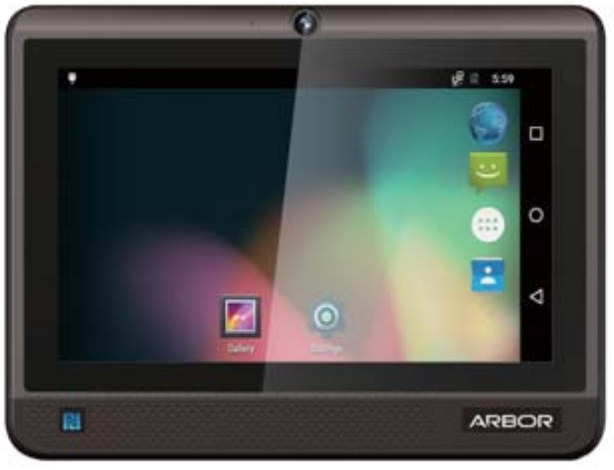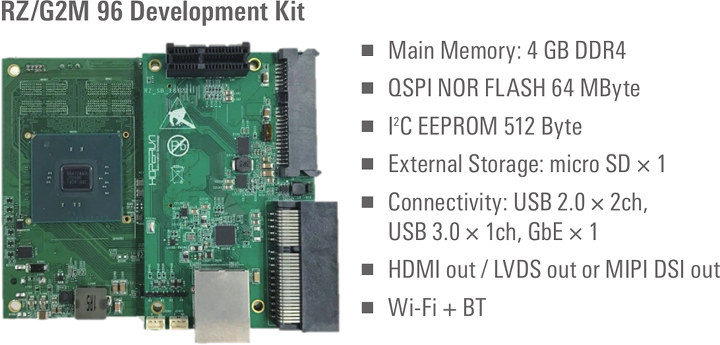While the Raspberry Pi boards are mostly promoted as tools to teach STEM to kids and adults alike, they have found their way in a fair amount of industrial products, including ModBerry M500 industrial computer, Janz Tec emPC-A/RPI3 industrial embedded controller, and Kunbus RevolutionPi RevPi Core among others. There’s yet another option with Brainboxes BB-400 Neuron Edge industrial controller that was announced last year with Raspberry Pi Compute Module 3, but recently got an upgrade to Raspberry Pi Compute Module 3+. The controller features two Ethernet ports and also includes an Arduino compatible microcontroller to control the system’s eight configurable digital inputs and outputs. BB-400 Neuron Edge industrial controller specifications: SoM – Raspberry Pi Compute Module 3+ with Broadcom BCM2837B0 quad-core , Cortex-A53 processor @ 1.2GHz, 1 GB LPDDR2, 32GB eMMC Flash storage MCU – Unnamed Microchip Atmel Arduino compatible microcontroller Connectivity Ethernet Uplink Port – 1x RJ45 jack, 10/100Mbps […]
ARBOR IoT-800N Android/Ubuntu Panel PC Targets Automotive Applications, Industrial Automation
Rockchip PX30 is a low cost low power quad core Arm Cortex-A35 processor mostly designed for car infotainment systems. Last month, we also found the processor in ARBOR SOM-RP301 system-on-module designed for retails kiosks such as automated currency exchange machines, electronic restaurant menus, , ticketing kiosks, etc… ARBOR has now launched another Rockchip PX30 platform with their IoT-800N 8″ Panel PC running Android 8.1 or Ubuntu 16.04, and designed for automotive applications such as fleet management or driver fatigue monitoring thanks to interfaces like OBD-II, as well as industrial automation. ARBOR IoT-800N specifications: SoC – Rockchip PX30 Quad-core Arm Cortex-A35 processor System Memory – 2GB DDR4 memory soldered on board Storage – 16GB eMMC flash soldered on board, microSDHC/microSDXC/microSD card socket up to 128GB Display – 8” TFT LCD display with 1024 x 600 resolution, 5-point projected capacitive touchscreen Camera – 8MP front-facing MIPI CSI camera with auto-focus Audio – […]
miriac MPX-LS1028A NXP QorIQ LS1028A SoM Targets TSN Applications with HMI Display
NXP QorIQ LayerScape LS1028A communication SoC was first unveiled in March 2017 with two Armv8 cores, GPU and LCD controller for HMI systems, as well as Time-Sensitive Networking (TSN) capabilities useful in industrial settings. As usual it takes a while before the company finalize their design and software support, but LS1028A has started to appear at least in one hardware platform that’s supposed to launch this quarter (Q2 2019): MicroSys miriac MPX-LS1028A system-on-module. miriac MPX-LS1028A SoM specifications: SoC – NXP QorIQ LS1018 / LS1028 single / dual core Arm Cortex-A72 clocked at up to 1.3 GHz with MXC Vivante GPU, Mali Display Processor, configurable cryptographic offload engines (Optional: LS1017/LS1027 without GPU for cost saving) System Memory – Up to 4GB 32 Bit DDR4 with ECC RAM at up to 1600 MT/s Storage – Up to 256MB Serial NOR Flash & up to 4GB Serial NAND Flash; EEPROM MXM 2.0 edge […]
Novasom M7 SBC aims to be a Drop-In Replacement for Raspberry Pi 3 in Industrial Projects
Raspberry Pi boards are great for education and hobbyist projects, and while they are also found in industrial projects, they may not be the ideal solution for such commercial projects because of potential availability issues, stability issues in demanding environments, lack of certifications, and lack of commercial support. Novasom RASPMOOD family of SBCs aims to provide a drop-in replacement for Raspberry Pi based designs by providing mechanically and electrically compatible boards, as well as a software layer that allows the RASPMOOD boards to leverage the software you’ve already developed for your Raspberry Pi 3 design. Today we’ll specifically look at Novasom M7 “RASPMOOD” board – aka SBC-M7 – powered by a Rockchip RK3328 processor. Specifications: SoC – Rockchip RK3328 quad core Cortex-A53 processor with Mali-450MP4 GPU System Memory – Up to 4 GB DDR3 RAM Storage – Up to 256 GB eMMC Flash + uSD slot Video Output – HDMI […]
ARBOR Introduces SOM-RP301 Rockchip PX30 SoM for Retail Kiosks
Rockchip PX30 is a quad core Cortex-A35 processor with a dual VOP (Video Output Processor) in order to drive two independent displays, that has low power consumption, low thermal requirements, and that we previously found in some car infotainment systems. But the processor is also suitable for other applications, and ARBOR Technology recently launched SOM-RP301 system-on-module based on the PX30 processor, and specifically designed for fanless retail kiosks such as electronic restaurant menus, automated currency exchange machines, ticketing kiosks and more. SOM-RP301 system-on-module specifications: SoC – Rockchip PX30 quad core Cortex-A35 processor @ 1.5 GHz with Arm Mali-G31 MP2 GPU System Memory – 1GB LPDDR3 (Up to 4GB as option) Storage – 16 GB eMMC flash Connectivity – Fast Ethernet transceiver, 802.11 b/g/n/ac WiFi 5 + Bluetooth 4.0 module Edge Connector – SO-DIMM connector with Display – LVDS or MIPI DSI Camera – MIPI CSI RX interface with 8MP ISP […]
$30 Arch Mix Development Board Features NXP i.MX RT1052 Crossover Processor
NXP i.MX RT Arm Cortex-M7 crossover processors are supposed to fill the gap between microcontrollers and more powerful application processors thanks to real-time capabilities, and a higher CPU frequency. We’ve already covered several i.MX RT1050 series platforms including NXP’s own evaluation board and Forlinx OK1052-C development kit comprised of a carrier board and an i.MX RT1052 system-on-module. But if you’d like to experiment with NXP i.MX RT processor using a cheaper, smaller, and easier to purchase development platform, Seeed Studio has started to sell Arch Mix development board for $29.90 plus shipping. Arch Mix board specifications: SoC – NXP i.MX RT1052 Arm Cortex-M7 processor @ up to 528MHz System Memory – 32MB SDRAM Storage – Optional 64MB Hyperflash, 8MB QSPI flash, microSD card socket Display I/F – RGB LCD interface USB – 1x micro USB 2.0 host port, 1x USB OTG port for data and power Expansion Headers – 2x […]
AAEON RTC-1010M Semi Rugged Tablet Runs Windows 10 IoT or Android 9
AAEON has introduced a new semi-rugged Intel Apollo Lake tablet with a 10.1” sunlight readable screen, IP54 certification, and optional modules such as a smart card reader, magnetic stripe reader (MSR) and 2D barcode scanner, as well as various mounting options from docking mounts to shoulder belts. The choice of operating system is also interesting for AAEON RTC-1010M tablet as it will come with Windows 10 IoT by default, and support for Android 9 is planned for Q2 2019. AAEON RTC-1010M tablet specifications: SoC (One or the other) Intel Celeron N3350 dual core processor @ 1.1 GHz / 2.4GHz (Turbo) with Intel HD graphics; 6W TDP Intel Pentium N4200 quad core processor @ 1.1GHz / 2.5GHz (Turbo) with Intel HD graphics; 6W TDP System Memory – 4 GB DDR3L (Default), up to 8GB Storage – 64GB eMMC flash, microSD card slot, optional mSATA III drive up to 512GB Display – […]
Renesas RZ/G2 64-Bit MPUs Target Industrial Applications Leveraging SLTS Linux
Renesas RZ/G1 Cortex-A15/A7 processor series was introduced in 2016 targeting industrial human machine interface, and RZ/G1M was one the the first processors supported by the industrial-grade CIP Super Long-Term Support (SLTS) Linux kernel – as part of Renesas RZ/G Linux Platform – with commitment of over 10 years of support. The company has now launched a 64-bit version of the industrial processors with Renesas RZ/G2 family featuring up to eight Cortex-A53/A57 cores and supported by RZ/G Linux Platform for long term Linux support. Renesas RZ/G2 family is now comprised of four SKUs with the following key features and specifications. RZ/G2 Series RZ/G2E RZ/G2N RZ/G2M RZ/G2H Economical Mid-Range (Pin Compatible) Highest Performance CPU (64-bit ARMv8A) 2x Cortex-A53 @ 1.2GHz L1, L2 Parity/ECC 2x Cortex-A57 @ 1.5GHz L1, L2 Parity/ECC 2x Cortex-A57 @ 1.5GHz 4x Cortex-A53 @ 1.2GHz L1, L2 Parity/ECC 4x Cortex-A57 @ 1.5GHz 4x Cortex-A53 @ 1.2GHz L1, L2 Parity/ECC […]










